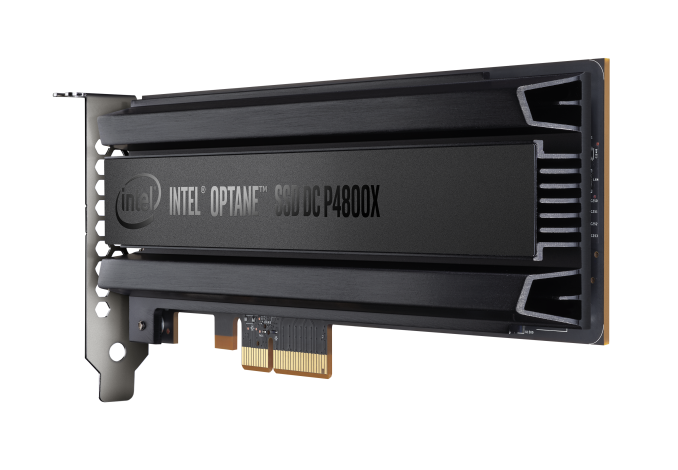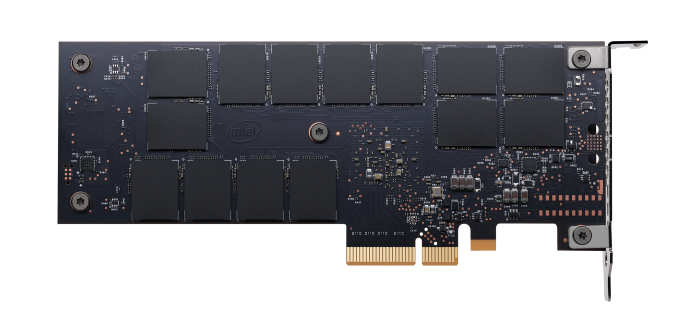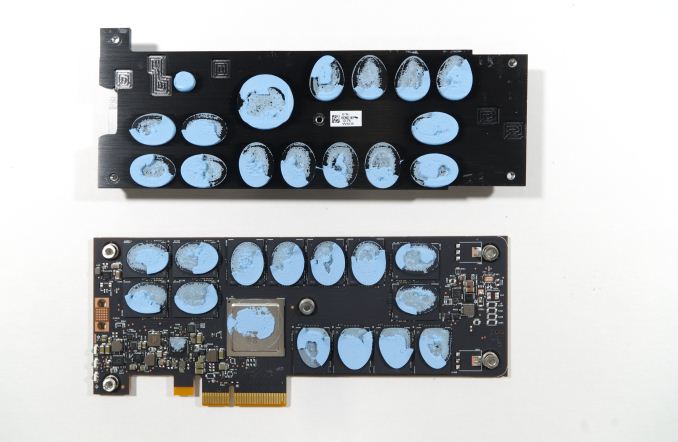Intel Optane SSD DC P4800X 750GB Hands-On Review
by Billy Tallis on November 9, 2017 12:00 PM EST
Intel's rollout of Optane products, based on 3D XPoint memory, continues. Today is the release of the 750GB Optane SSD DC P4800X, a larger capacity version of the model launched earlier this year. Now Intel's flagship enterprise SSD family has a more useful capacity while offering the same chart-topping performance as the 375GB model that launched earlier this spring.
We tested the 375GB model earlier this year through remote access to an Intel server lab. Last month, we reviewed the consumer counterpart to the P4800X, the Intel Optane SSD 900p. Today, we have the results of hands-on testing of the 750GB P4800X add-in card model.
The 750GB add-in card model was originally planned for a Q2 introduction, followed by the 750GB U.2 model and the 1.5TB models in the second half of 2017. Both 750GB models are now launching, and Intel says the 1.5TB models are "coming soon". This is a fairly minor delay, but that is of little comfort to customers who have been eagerly awaiting drives like this since 3D XPoint memory was first announced in July 2015.
| Intel Optane SSD DC P4800X Specifications | |||
| Capacity | 375 GB | 750 GB | |
| Form Factor | PCIe HHHL or 2.5" 15mm U.2 | ||
| Interface | PCIe 3.0 x4 NVMe | ||
| Controller | Intel SLL3D | ||
| Memory | 128Gb 20nm Intel 3D XPoint | ||
| Typical Latency (R/W) | <10µs | ||
| Random Read (4 kB) IOPS (QD16) | 550,000 | ||
| Random Read 99.999% Latency (QD1) | 60µs | ||
| Random Read 99.999% Latency (QD16) | 150µs | ||
| Random Write (4 kB) IOPS (QD16) | 500,000 | ||
| Random Write 99.999% Latency (QD1) | 100µs | ||
| Random Write 99.999% Latency (QD16) | 200µs | ||
| Mixed 70/30 (4kB) Random IOPS (QD16) | 500,000 | ||
| Sequential Read (64kB) | 2400 MB/s | ||
| Sequential Write (64kB) | 2000 MB/s | ||
| Active Power | Read | 8 W | 10 W |
| Write | 13 W | 15 W | |
| Idle Power | 5 W | 6 W | |
| Endurance | 30 DWPD | ||
| Warranty | 5 years | ||
| MSRP | $1520 | ||
The performance specifications of the Optane SSDs stand out in several ways.
The latency for reads at low queue depths is far lower than NAND flash-based SSDs. This can provide a boost to almost any application that waits on storage. With no complicated wear leveling and garbage collection process going on under the hood, the Optane SSDs offer much better performance consistency than most flash-based SSDs, to the point that Intel specifies 99.999th percentile latency for the Optane SSD.
Perhaps most significant is that capacity doesn't affect performance. For flash-based SSDs there is usually a very strong correlation between capacity and performance. The simpler, more direct architecture of Optane SSDs cuts out most of the intermediate buffering that flash SSDs need to perform well.
The sequential transfer speeds of the P4800X are not record-setting, and the read speed rating is actually 100MBps lower than that of the consumer Optane SSD 900p. However, nobody is going to buy an Optane SSD primarily for its sequential performance when flash-based SSDs can compete in that aspect at a fraction of the price. It is interesting to note that the sequential performance specifications are given for 64kB transfers, when 128kB is more common within the industry and 128kB transfers are supported by the Optane SSD.
Power consumption is the only area where the specifications differ between the 375GB and the 750GB model. The SSD DC P4800X does not implement the standard NVMe power state management or Autonomous Power State Transition features, but it does have a power governor setting controllable through vendor specific commands. This allows the P4800X to be limited to 12W instead of the default limit of 18W. Since imposing a lower power limit will reduce performance, this feature is probably not going to get much use with a product like the P4800X. There may be a few situations where it could be of use with the U.2 model that has less surface area for cooling, provided that it leads to more consistent performance than simply letting the drives thermally throttle.
The P4800X's write endurance rating of 30 drive writes per day is far higher than most enterprise SSDs and beats any previous Intel SSD, but it isn't actually high enough to put the Optane SSD in an entirely different class from the best high-endurance flash based SSDs. When the P4800X exhausts the rated write endurance, it will switch to a "write protect" mode where writes are throttled to 30MB/s. This is a gentler end of life strategy than the hard read-only mode that some of Intel's previous drives have used. The mode switch happens when the "Percentage Used Estimate" SMART indicator reaches 105%.
Once the P4800X has reached its write endurance rating, it is specified for unpowered data retention of 3 months, which is standard for enterprise SSD. Intel doesn't say anything directly about data retention when the drive is new, but the do caution that the drive will perform background data refreshing. When the drive is powered on, it will devote more time than usual to background data refreshing for a period of about three hours, to clean up any data degradation that may have occurred while the drive was off for an unknowable period of time.
| Model | Dies per channel | Channels | Raw Capacity | Spare Area | |||
| Intel Optane SSD 900p 280GB | 3 | 7 | 336 GB | 56 GB (16.6 %) | |||
| Intel Optane SSD DC P4800X 375GB | 4 | 7 | 448 GB | 73 GB (16.3 %) | |||
| Intel Optane SSD 900p 480GB | 5 | 7 | 560 GB | 80 GB (14.3 %) | |||
| Intel Optane SSD DC P4800X 750GB | 8 | 7 | 896 GB | 146 GB (16.3 %) | |||
The Optane SSD DC P4800X and the Optane SSD 900p both use the same 7-channel controller, which leads to some unusual drive capacities. The 900p comes with either 3 or 5 memory dies per channel while the P4800X has 4 or 8. All models reserve about 1/6th of the raw capacity for internal use.
Aside from the number of 3D XPoint memory packages and the number of dies they contain, the PCBs of the P4800X and the 900p differ only in the presence of a few diagnostic LEDs on the P4800X. Neither model has any large power loss protection capacitors because the Optane SSDs don't use any volatile caches and write immediately to the 3D XPoint memory itself.
The heatsinks and PCIe brackets are slightly different between the consumer and enterprise versions, but both are predominately black aluminum. The P4800X omits the solid backplate and instead places the label with model and serial numbers on the side of the heatsink.












58 Comments
View All Comments
Elstar - Thursday, November 9, 2017 - link
I thought the whole point of 3D XPoint memory would be that it is DIMM friendly too.1) When will we see this in DIMM form?
2) Would the DIMM version also need/have the reserved/spare capacity?
3) Why is this spare capacity even needed? 1/6th seems like a potentially high internal failure rate (or other fundamental problem.)
PeachNCream - Thursday, November 9, 2017 - link
It seems like current 3D XPoint doesn't have enough endurance yet to sit in a DIMM slot unless it's gonna be just a storage drive in DIMM form factor. That and because we're only just now seeing early enterprise and retail products, I bet that we're gonna need another generation or two before we get DIMM versions. :(Billy Tallis - Thursday, November 9, 2017 - link
Intel hasn't said much about 3D XPoint DIMMs this year, other than to promise we'll hear more next year.It's not clear how much fault tolerance Intel is trying to build in to the Optane SSDs with the extra capacity. A bit of it is necessary to support sector formats with protection information (eg. 16 extra bytes per 512B sector, or 128B extra for each 4kB sector). Beyond that, there needs to be room for the drive's internal data structures, which aren't as complicated as a flash translation layer but still impose some space overhead. The rest is probably taken by a fairly simple erasure coding/ECC scheme, because it's almost impossible to do LDPC at the speed necessary for this drive. (That's also why DIMMs use simple ECC instead of more space-efficient codes.)
woggs - Thursday, November 9, 2017 - link
Most all intel SSDs have a parity die, so one full die likely provides internal raid protection of data. The rest is for ECC, internal system information, media management and mapping out defects... Impossible to know which of these is driving the actual spare implemented. I count 14 packages, so 1/14th (7%) is already the internal parity. 16% is big relative to nand consumer SSDs but comparable to enterprise. Doesn't seem particularly out of line or indicative of something wrong.CheapSushi - Thursday, November 9, 2017 - link
Micron is probably working on the DIMM version.woggs - Tuesday, November 14, 2017 - link
Intel is working on DIMMs... "Now, of course, SSDs are important, but in the long run, Intel also wants to have Optane 3D XPoint memory slot into the same sockets as DDR4 main memory, and Krzanich brought a mechanical model of an Optane DIMM to show off." https://www.nextplatform.com/2015/10/28/intel-show...MajGenRelativity - Thursday, November 9, 2017 - link
I enjoyed the review. Keep up the good work!melgross - Thursday, November 9, 2017 - link
I’m curious as to how this will perform when PCI 4 is out next year. That is, one with a PCI 4 interface. How throughput limiting is PCI 3 for this right now?MajGenRelativity - Thursday, November 9, 2017 - link
It shouldn't be that limiting, as PCIe 3.0 x4 allows for a higher throughput than 2.4 GB/s. There could be some latency improvements (probably small), but I don't think throughput is the issuewoggs - Thursday, November 9, 2017 - link
If the question is "could a drive be made to saturate gen 4?" then, yes, of course, if intel chooses to do so. Will require a whole drive. Latency is a more interesting question because that is what 3dxp is really providing. QD1 latency is <10us ((impressive!). I don't expect that to improve since it should be limited by the 3dxp itself. The PCIe and driver overhead is probably 5us of that. Maybe gen 4 will improve that part.